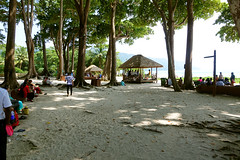Chail is one of my favourite weekend destinations. I first discovered the sylvan charms of Chail while pursuing post-graduation in communication studies from Panjab University in the City Beautiful Chandigarh. Back then, we would often make weekend trips to Chail on our motorbikes. I vividly remember the first spicy smell of pine trees and the scent of those charming wild roses as we rode from Chandigarh to climb the higher foothills.
Just before the current monsoon season, I was in Chail again on a weekend to escape the summer heat of plains. Sitting in the courtyard of the decrepit Junga Palace while sorting out my knickknacks to gear myself up for the day’s hike to the cooler environs of Chail, I ruminated about my earlier escapes from Chandigarh on weekends. I remember how beautiful Chail looked; how cool and scented after the heat and dust of the plains. Wild flowers, chirpy birdies, pine needles and wood smoke; Lovely!

The doorway of the old Junga Palace that is in a state of neglect now. Image by Sarabjit Lehal. More at Flickr

The doorway had numerous coins nailed on its frame; said to be signifying the answered prayers. More at Flickr

From the courtyard of the erstwhile Junga Palace! More images from the region at Flickr

Derelict paintings inside the building. For more images from the region, please visit Flickr
One of the memories for which I consider myself to be fortunate is that I have been visiting Chail from the days when just a few vehicles travelled to this part of the Himalayas. Minus any fuel fumes, no loud bangs, blaring horns or screeching tyres, no SUVs or transport trucks belching reeking clouds of diesel exhaust, and pedestrians walking carelessly, it was total peace. It was wonderful. Those were the days that continue to inspire me for weekend outings.
The settlement of Junga, an erstwhile princely state, is surrounded by green hills with Shimla in front. The green environs of Kufri are to the northeast and the rich Chail Wildlife Sanctuary is towards the south of Junga. The rich forest cover comprises trees of kail, deodar, pine, cheel and ban, etc. The settlement of Junga is the midpoint and a popular stopover on the traditional trail between Shimla and Chail. With the advent of roads in the area, the trail is, however, seldom used these days except possibly by herders, runners or for soft adventures, which is what we planned to do.

The initial part of the trail; the Karol Ka Tibba towering in front. More images from the region at Flickr

Plucking wild edible berries as we start. More images from the region at Flickr

The route we took was part of the centuries-old Shimla-Chail trail and was much frequented before the roads forayed into the lush green hills. More images from the region at Flickr
Starting from Junga at breakfast time, we planned to reach Chail by evening tea time. The length of the trail from Junga (1560m) to Janedghat at Chail (2224m) is a little less than nine km. Having packed our lunch and some fruits in our day backpack plus two litres of water, full of energy we left for Chail. It was a sunny day and in the initial hour of walk we were sweating profusely. The trail passes through some quaint hamlets and then proceeds on to the densely forested slopes of the Chail Wildlife Sanctuary. The shade of wooded ridge after the second kilometre gave us some respite from the heat. The entire hillside of Shimla including the neighbouring Shoghi was clearly visible. Not only the capital Shimla but the picturesque settlement of Junga with several interesting olden buildings and structures can also be plainly seen from the ridge we were skirting.

The settlement of Junga is the midpoint and a popular stopover on the traditional trail between Shimla and Chail.

Not an uncommon sight given the season, a forest fire on the opposite side of the ridge. More at Flickr

All the seven hills of Shimla including the tall red statue of Lord Hanuman atop the Jakhu hill were clearly visible from the trail. Photo by Sarabjit Lehal. More images from the region at Flickr
Owing to its proximity and richness, the forests of Junga we were passing through used to be one of the preferred hunting sites for the officers in Shimla during the British rule. During those times, Junga, the capital of the erstwhile Keonthal state surrendered many villages to form the present station of Shimla. The gazetteer adds that the chief of Keonthal used to be called a Rana but in the mutiny Rana Sansar Sen behaved most loyally giving shelter and hospitality to many Europeans who fled from Shimla when it was feared that the Gurkha regiment stationed there had become disloyal. The title of Raja was conferred on him in perpetuity for these services.

The trail passes through some quaint hamlets and then proceeds on to the densely forested slopes of the Chail Wildlife Sanctuary

A well earned lunch in the shade. Please visit Flickr for more images of the region

The shade of wooded ridge after the second kilometre gave us some respite from the heat. More at Flickr
Once a retreat of a few solitude loving British officials, hunters and explorers, the hillside we were walking through is fast turning into a preferred holidaying destination. Although devoid of any snowy view, the Chail Widlife Sanctuary is truly a walker’s paradise. The wooded charm of this region will be a pure delight for a birding enthusiast. On my walk, I spotted 27 different species of birds and pheasants including a lifer. As we gained height, the weather became cooler. All the seven hills of Shimla including the tall red statue of Lord Hanuman atop the Jakhu hill were clearly visibly from the trail. We lunched at one of the several meadows we crossed on the way. It took us nearly six hours at a leisurely pace to cover the distance between Junga and Janedghat, a popular trailhead located three km before the hiker’s paradise of Chail.

The shade of wooded ridge after a few kilometers gave us some respite from the heat. More at Flickr

A water break atop one of the many meadows we crossed. More images from the region at Flickr

The rich forest cover comprises trees of kail, deodar, pine, cheel and ban, etc. More images at Flickr

The settlement of Junga is the midpoint and a popular stopover on the traditional trail between Shimla and Chail.

With the advent of roads in the area, the trail is, however, seldom used these days except possibly by herders, runners or for soft adventures.

Tea break atop another meadow. Please visit Flickr for more images of the region

The wooded charm of this region will be a pure delight for a birding enthusiast. On my walk, I spotted 27 different species of birds and pheasants including a lifer.

As we gained height, the weather became cooler. More images from the region at Flickr

Owing to its proximity and richness, the forests of Junga we were passing through used to be one of the preferred hunting sites for the officers in Shimla during the British rule. More at Flickr
The route we took was part of the centuries-old Shimla-Chail trail and was much frequented before the roads forayed into the lush green hills. The trail, mostly unmarked in the confines of the sanctuary, climbs over 700 m to reach Chail, once the summer retreat of Maharaja of Patiala and now spread over a cluster of three popular hills Pandhawa, Rajgarh and Sidh Tibba. Today, the sleepy hillside of Chail stands as a faint reminder of the times of how the salubrious environs of Shimla would have looked before the British forayed in.

The market square-cum-taxi stand of Chail. Please visit Flickr for more images of the region

A tea shop-cum-dhaba in the market. Please visit Flickr for more images of the region
Offering a peaceful vacation, Chail does not have a Mall or a shopping arcade; though a huddle of shops that double up as a bus stop include grocery and vegetable vendors, dhabas and chemists. The chief heritage attraction of the town is the HPTDC run Palace Hotel. The hillside became accessible to visitors after the Patiala royals handed over the 75-acre property, where Maharaja Bhupinder Singh of Patiala spent six months in a year, to the government in 1972. The Palace is popular with honeymooning couples and weekenders who hop in for a day or two of princely excitement. On weekends, it would be nearly impossible to get a foothold in the Palace. On weekdays, enjoy the tranquillity of the surroundings and countryside.

The Chail Palace garden on a busy summer weekend. More images from the region at Flickr

The recently renovated interiors of the Chail Palace. More images from the region at Flickr
Ever since its inception, the palace is said to have reverberated with the sounds of partying and merry-making. The gazetteer notes that couples drank from sidecars and smoked cigarettes leaning against staircases while listening to tunes played on a grand piano. Inside, the peeling, water-soaked walls; worn, musty carpets; dilapidated woodwork and furniture; dusty chandeliers, etc. might add to the disappointment but on the positive side, the exteriors are, however, surprisingly well kept. Sitting on the white-painted wrought iron benches in the lawn, muse over the gossips and stories of the Palace and hear innumerable accounts of Maharaja’s personal life.

The Churdhar towering above a fertile ridge of Chail. Photo by Sarabjit Lehal. More images at Flickr

The Sidh Baba Ka Mandir. Photo by Sarabjit Lehal. More images from the region at Flickr
Another attraction, Sidh Baba Ka Mandir is placed atop a ridge sandwiched between Rajgarh and Pandhawa hills. Part of the army cantonment area, the temple is built near the cricket stadium. The site is nearly 4km from the market square and is surrounded by a dense cover of woods. One more temple of repute is the Kali Ka Tibba, located a little further; six km from the market. The prize catch would certainly be the evening view from the Kali Ka Tibba – with foothills on one side, sinking down in line after line until beyond them you could feel the plains stretched out; and on the other, the Churdhar; as also the high Himalayas.

The temple atop the Kali Ka Tibba glittering in the evening light. Photo by Sarabjit Lehal. More at Flickr

The skyscape at sunset from the Kali Ka Temple. Photo by Sarabjit Lehal. More images at Flickr
Getting There
The hill-station of Chail is 25 km from Kandaghat on the Kalka-Shimla highway. Chail to Kufri on the Shimla-Theog highway is 31 km. The approach from both sides is fairly easy. The road distance between Junga and Chail is 21 km.
Average Altitude: 2000m
Best time to visit: Round the year, avoid holiday seasons
Travel Lure: Himalayan views, heritage and sylvan charm
Accommodation: Plentiful
 bNomadic
bNomadic














Fantastic write up. Loved the pictures. I have been to chail many times but not really walked through the sanctuary. Loved the post.
Thanks Tikuli! A walk through the sanctuary is totally recommended. Keep visiting bNomadic 😊
Writing, perhaps the closest thing to time travel there exists 😊 And I keep appreciating the way you take the readers through not just the information but the experience of the travel. The pictures are significantly more attractive for this article though…bet there was some secret ingredient in the breakfast! 😉
Hey Enakshi! Thanks for stopping by the blog. The pictures will be the strength from now on. You’d get to see that in the days to come. Not only the breakfast but the entire weekend was totally loaded with that secret ingredient. 😊😊 Keep visiting bNomadic
Such a detailed post and fabulous snaps! Surely bookmarking ths for the future 🙂
Thanks for stopping by the blog guys! Glad to know you liked the post. Keep visiting bNomadic for more such travel stories 😊
A beautiful trail.. Beautifully presented
Thanks Ruma for stopping by the blog! and for showering it with appreciation. Keep visiting bNomadic for more such travel stories 🙂
The expanse is lovely 🙂 Captured well in pictures
Thanks Sandy for stopping by the blog. Happy to know you liked the post. Keep visiting bNomadic for more such travel stories 😊
Awesome work.Just wished to drop a comment and say i’m new your journal and adore what i’m reading.Thanks for the share
Amazing diary and extremely fascinating stuff to procure here! I absolutely learned masses from reading through variety of your earlier posts additionally and set to drop a discuss this one!